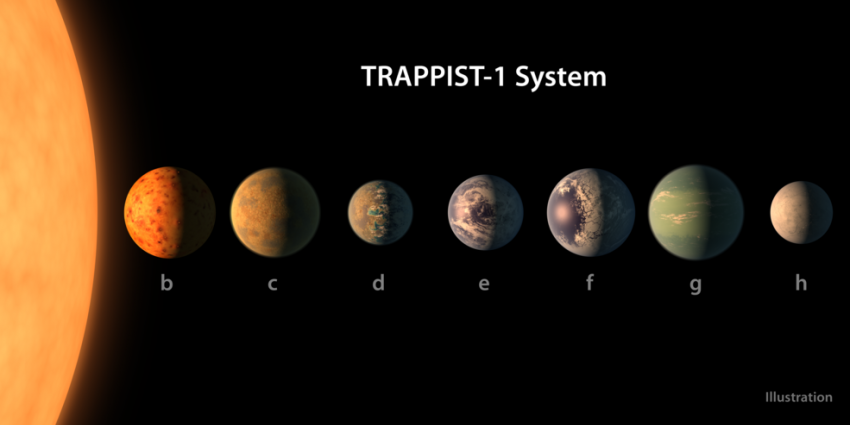
Humankind has looked up to the stars for millennia and wondered its own place in the universe. Some cultures created patterns to fit their beliefs in the stars themselves, others built complex algorithms to predict the movements of not only the heavens, but of the seasons on Earth itself. More recently, as we discover just how enormous the cosmos is, we ponder on whether we are alone. Well that question is even more relevant today with the discovery of seven Earth-sized planets in the Trappist 1 system (named after The Transiting Planets and Planetesimals Small Telescope in Chile). This is the largest grouping of exoplanets (planets found outside our solar system) that we have found to date but that is not the only thing that makes them extra special.
Three of the planets are located in the now oft-used Goldilocks Zone; a zone that our own Earth resides in that has the best conditions for life to evolve, or in simpler terms, liquid water. NASA’s Spitzer Space Telescope found these in the constellation Aquarius, located about 40 light-years away. That is within spitting distance in astronomical terms and also a great place for an invasion to come from. I mean we only have three planets with the possibility of habitation, they have seven!
Back in 2016 scientists had already discovered three of the planets with TRAPPIST and other ground-based telescopes. They have even managed to calculate their sizes, masses, and distance to their sun. A distance that puts them much closer than we are. In fact because the sun is an ultra-cool dwarf, water is still liquid with the planets in a closer orbit than our own Mercury. They are so close that they may even be tidally locked, so only one side of planet faces the sun, while the other is in perpetual darkness. So the perfect place for a penal colony, right Riddick?
Sean Carey, manager of NASA’s Spitzer Science Center in California said:
This is the most exciting result I have seen in the 14 years of Spitzer operations. Spitzer will follow up in the fall to further refine our understanding of these planets so that the James Webb Space Telescope can follow up. More observations of the system are sure to reveal more secrets.
Over the next few decades you can be sure we will probe the heck out of these cousin planets, and who knows, maybe we’ll find they have basic life.
Thomas Zurbuchen, of the Science Mission Directorate in Washington seems to think that’s possible:
This discovery could be a significant piece in the puzzle of finding habitable environments, places that are conducive to life. Answering the question ‘are we alone’ is a top science priority and finding so many planets like these for the first time in the habitable zone is a remarkable step forward toward that goal.
Talk about setting up the grounds for a science fiction film where we pack a bunch of colonists off to populate a new Earth-like-planet. Let’s just hope there are no xenomorphs there to welcome them.
Last Updated: February 23, 2017





















Hargrim
February 23, 2017 at 14:12
Seeing other planets in the sky like we see our moon. Now that is a view I would leave Earth for
When are we going NASA? I’m in
HvR
February 23, 2017 at 14:25
Check with the CNSA or ISRO; NASA’s budget has been diverted to more important for more important things like safe spaces and smug mobiles.
Lu
February 23, 2017 at 15:52
Hahaha would be funnier if it wasn’t so sadly true
Skyblue
February 23, 2017 at 14:41
Just have to figure out how to get there now, fook dis place, too many assholes (literally) to sustain it.
Skoobaz
February 23, 2017 at 15:46
Ok so at current tech if we launched a probe and slingshot the hell out of our solar system to attain max V we’d get there in say oh I dunno, 171,000 years. But hey, at least beaming back the data would take maybe just a little longer than another 40 years on top of that.